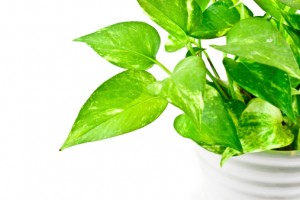Seven Household Plants That Can Improve Your Home’s Indoor Air Quality

1. Peace Lily (Spathiphyllum)
This perpetually flowering air purifier does well in low light, but requires attentive watering. Peace lilies are excellent at removing volatile organic compounds (VOCs) like benzene and acetone that are present in paints and polishes as well as adhesives and cleaning products.
2. Aloe (Aloe vera)
Aloe plants grow best with plenty of light, but are otherwise very easy to maintain with minimal watering. This succulent can help to remove VOCs like benzene and formaldehyde from indoor environments, and the raw plant can be used to treat burns and cuts.
3. Spider Plant (Chlorophytum comosum)
An extremely hardy houseplant, spider plants are capable of soaking up formaldehyde and benzene as well as carbon monoxide and xylene (a chemical frequently used in the printing industry). This easy-care plant grows quickly, and eventually produces tiny offspring that can be planted in their own pots.
4. Lady Palm (Rhapis excelsa)
The lady palm is a larger, tree-like plant that is easy to maintain (though somewhat slow-growing). In addition to adding a touch of the tropics to your home, this plant can filter out ammonia fumes that may cause respiratory irritation–a common ingredient in modern dyes, textiles, and household cleaners.
5. English Ivy (Hedera helix)
Easy to grow and maintain even with little direct sunlight, the dense foliage of English ivy is perfect for absorbing the formaldehyde present in many floorboard resins and manmade chemical dyes.
6. Snake Plant (Sansevieria trifasciata)
Snake plants uniquely reverse the typical chemical process of photosynthesis, absorbing carbon dioxide and releasing oxygen during the night, rather than day. Also known as mother-in-law’s tongue, snake plants are good for providing extra breathable oxygen and removing benzene, formaldehyde, and carbon dioxide.
7. Golden Pothos (Epipremnum aureum)
Similar in appearance to the perennially popular philodendron, golden pothos is a fast-growing vine that produces numerous waxy leaves. This efficient filterer is particularly good at purifying the air of formaldehyde and benzene, as well as carbon monoxide gas. These plants can survive fairly easily in low-light environments, making them perfect for a garage or adjacent mudroom where car exhaust and related fumes can enter the home. While a healthy population of indoor plants is a great natural way to reduce contaminants, air filtration is only one piece of the larger picture when it comes to maintaining good indoor air quality. If you are concerned about your home’s indoor pollution, H2 Environmental Consulting Services can assist with everything from contamination testing for carbon monoxide and formaldehyde to advice on improving existing ventilation systems and eliminating issues with mold and mildew.










